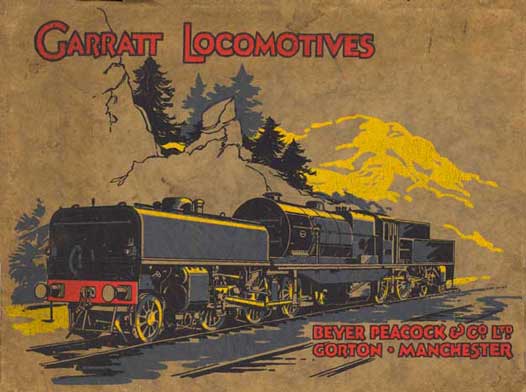Reprinted by Heimburger House Publishing, 7236 W. Madison St., Forest Park, IL 60130; 36 pages, 50 illustrations; softcover, 11.5 x 8.5 in.; $18.95
Heimburger House has published this reprint of a 1920s-era Beyer, Peacock & Co. Garratt locomotive catalog. To North American eyes, the Garratt is an unusual-looking machine, but the fact that examples of the type remain active in the 21st century is a testament to the soundness of the design. The locomotive has three frames: A boiler is mounted on the center frame, and two steam engines are mounted on separate frames, one on each end of the boiler. Designed and patented in 1907 by Herbert William Garratt, most examples were built by Beyer, Peacock of Manchester, England.
The first Garratt was built in 1909 for the Tasmanian Government Railways, and 15 years later, the type had been sold to 34 operators. The company proudly stated that a Garratt produced “the extra power required when the traffic conditions are beyond the capacity of normal types of locomotives.” Although not found in North America, Garratts operated in Australia, South America, Europe and Africa. As the manufacturer’s catalog indicates, they were built to suit the customers and appeared in many sizes and gauges.
Locomotives depicted in this catalog had tractive effort ranging from 7,950 to 69,150 lbs. at 75 percent boiler pressure.
Although the catalog is undated and Heimburger House reckons its date as “circa 1925,” an Internet search by the reviewer found that Argentina’s Entre Rios Railway’s 4-4-2+2-4-4s, shown in this reprint, were built in 1927. Regardless of when it was actually published, the catalog is an excellent example of marketing, 1920s style. The cover features a color painting of an unlettered Garratt with a snow-covered mountain in the distance. Inside, after a contents page, is a photograph of a South African Railways Garratt passing under a semaphore-covered signal bridge at Cape Town.
The catalog dates from an era when expository text was used to sell products. After a two-page introduction, 18 locomotive examples are presented. Each includes a builder’s photo and a brief explanation of how the operator uses the locomotive, followed by a table listing the pertinent statistics for the model. Ten pages of photographs showing Garratts in service round out the presentation.
It is interesting to read about the different variations of Garratts in service 90 years ago, but the reader will want to have an Internet connection handy to look up additional facts as needed. For example, one of the 2-6-0+0-6-2 30-inch-gauge locomotives built for Australia’s Victorian Railways operates today on the Puffing Billy Railway near Melbourne. For those interested in Garratt locomotives, or exotic railways in general, this catalog will be of interest.















There is one Garrat preserved in Brazil
Saw Gareth operating in qland Aust, both aust standard which were hated by Queensland rail staff but we're operated successfully by Portland cement and Emu bay rail in Tasmania and the later French built beyer gar rats operated in Qland.
A recent observation by a qland railway man was the main thing you had to remember was because of the length of steam passages you had to alter your controls at least a minute before they Took effect.
Qland used them in the coalfields Moura to Gladstone and NSW on coal around Newcastle and sometimes on grain.
1 is operational condition in Canberra and narrow gauge at Ipswich in Qland.